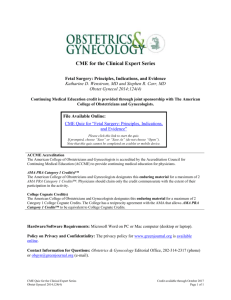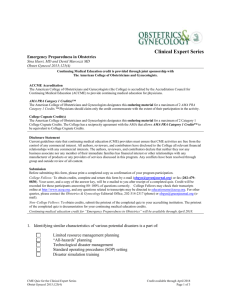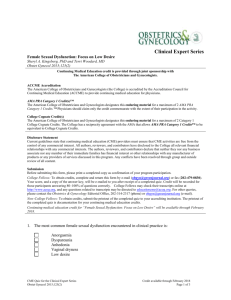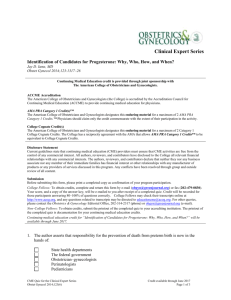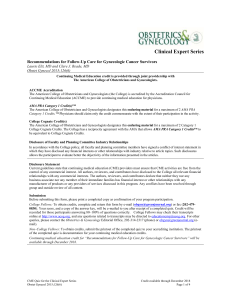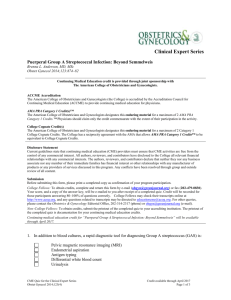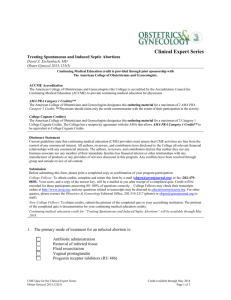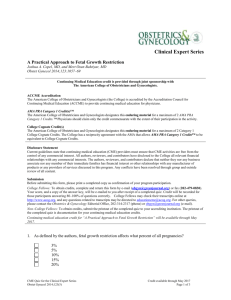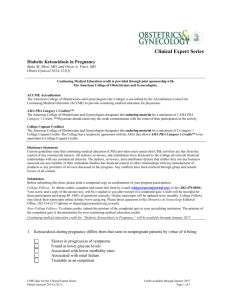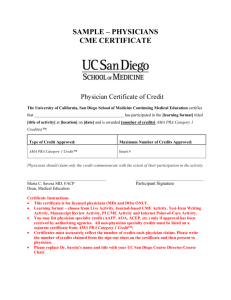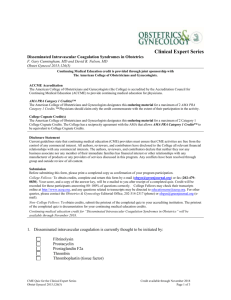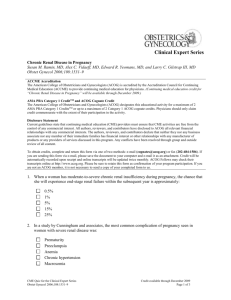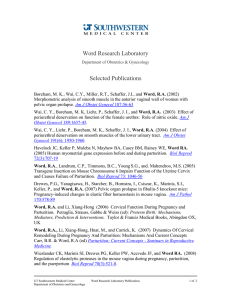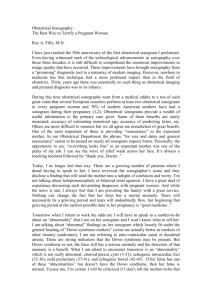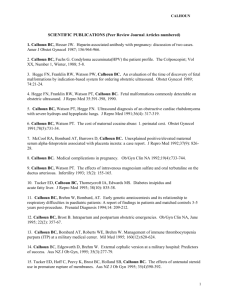Obstetric Safety and Quality
advertisement
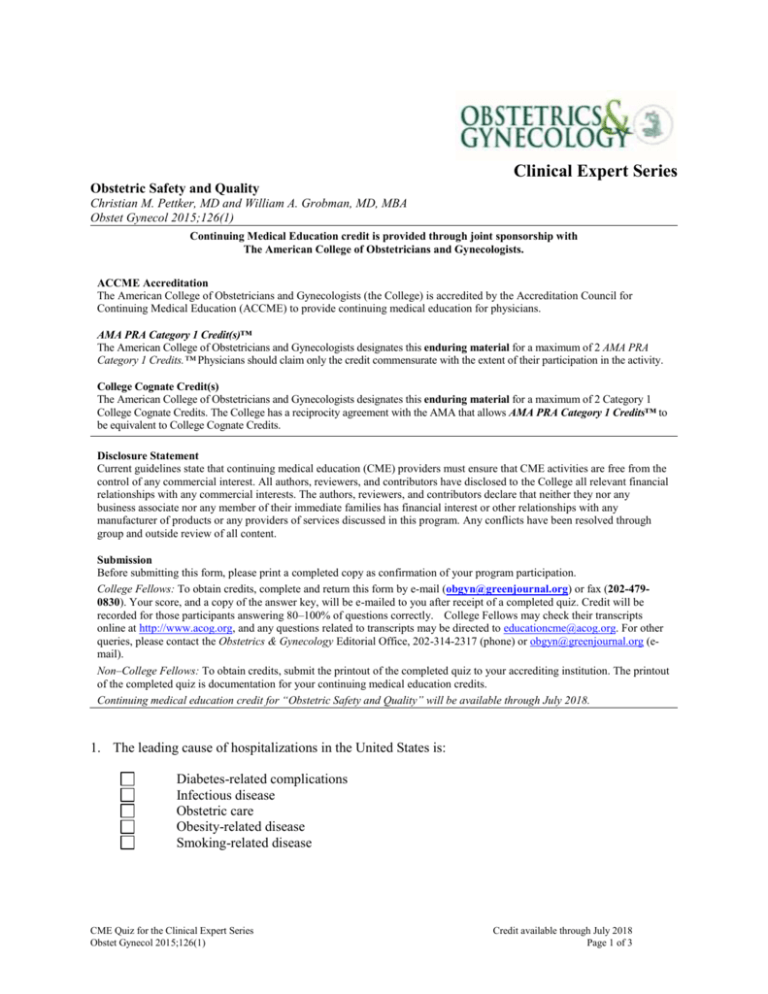
Clinical Expert Series Obstetric Safety and Quality Christian M. Pettker, MD and William A. Grobman, MD, MBA Obstet Gynecol 2015;126(1) Continuing Medical Education credit is provided through joint sponsorship with The American College of Obstetricians and Gynecologists. ACCME Accreditation The American College of Obstetricians and Gynecologists (the College) is accredited by the Accreditation Council for Continuing Medical Education (ACCME) to provide continuing medical education for physicians. AMA PRA Category 1 Credit(s)™ The American College of Obstetricians and Gynecologists designates this enduring material for a maximum of 2 AMA PRA Category 1 Credits.™ Physicians should claim only the credit commensurate with the extent of their participation in the activity. College Cognate Credit(s) The American College of Obstetricians and Gynecologists designates this enduring material for a maximum of 2 Category 1 College Cognate Credits. The College has a reciprocity agreement with the AMA that allows AMA PRA Category 1 Credits™ to be equivalent to College Cognate Credits. Disclosure Statement Current guidelines state that continuing medical education (CME) providers must ensure that CME activities are free from the control of any commercial interest. All authors, reviewers, and contributors have disclosed to the College all relevant financial relationships with any commercial interests. The authors, reviewers, and contributors declare that neither they nor any business associate nor any member of their immediate families has financial interest or other relationships with any manufacturer of products or any providers of services discussed in this program. Any conflicts have been resolved through group and outside review of all content. Submission Before submitting this form, please print a completed copy as confirmation of your program participation. College Fellows: To obtain credits, complete and return this form by e-mail (obgyn@greenjournal.org) or fax (202-4790830). Your score, and a copy of the answer key, will be e-mailed to you after receipt of a completed quiz. Credit will be recorded for those participants answering 80–100% of questions correctly. College Fellows may check their transcripts online at http://www.acog.org, and any questions related to transcripts may be directed to educationcme@acog.org. For other queries, please contact the Obstetrics & Gynecology Editorial Office, 202-314-2317 (phone) or obgyn@greenjournal.org (email). Non–College Fellows: To obtain credits, submit the printout of the completed quiz to your accrediting institution. The printout of the completed quiz is documentation for your continuing medical education credits. Continuing medical education credit for “Obstetric Safety and Quality” will be available through July 2018. 1. The leading cause of hospitalizations in the United States is: Diabetes-related complications Infectious disease Obstetric care Obesity-related disease Smoking-related disease CME Quiz for the Clinical Expert Series Obstet Gynecol 2015;126(1) Credit available through July 2018 Page 1 of 3 2. A system with a strong patient safety culture is characterized by: Advance approval by The Joint Commission Continuous quality-improvement projects Encompassing the entire health care team Implementation of quality measures Punitive measures to ensure individual performance 3. From a health care perspective, quality is the achievement of: Reduced cost of care Reduced inadvertent adverse events Reproducible health care results The best possible outcomes Uniform medical practices 4. Because failures cannot always be anticipated, effective patient safety programs should: Create layers of oversight (hierarchies) Establish quality standards Eventually fail Recognize and manage failure Reduce human involvement in care 5. The 2004 Joint Commission Sentinel Event Alert (SEA) report on preventing infant death found that the most common root cause of perinatal death is: Communication Staff competency Staffing Training Unavailability of prenatal records 6. One of the greatest barriers in designing safety interventions that can be assessed is: Confounding Institutional review board approval Lack of historical data Poor funding Staff resistance CME Quiz for the Clinical Expert Series Obstet Gynecol 2015;126(1) Credit available through July 2018 Page 2 of 3 7. After forming a team for a Plan-Do-Study-Act cycle study, the next step is to: Craft the intervention Define terms Determine how to measure Determine what to measure Set aims and objectives 8. Quality measures are often considered to come in the three forms of: Act, measure, and modify Clinical, process, and administrative Cost, efficiency, and safety Identify, modify, and clarify Structure, process, and outcome 9. The poor performance of hospitals on the Perinatal Care core measure set is primarily due to poor performance on the portion of the index related to: Breastfeeding Circumcision rates Elective deliveries prior to 39 0/7 weeks of gestation Newborn septicemia Primary cesarean deliveries 10. The obstetric adverse outcome index is limited as a quality measure by: Differing populations Domination by a single measure Inconsistent definition of terms Infrequent occurrence of measured events Reluctance of reporting agencies to provide full disclosure College ID Number: Name: Address: City/State/Zip: E-mail Address: Actual time spent completing this activity (you may record up to 2 hours): CME Quiz for the Clinical Expert Series Obstet Gynecol 2015;126(1) Credit available through July 2018 Page 3 of 3
